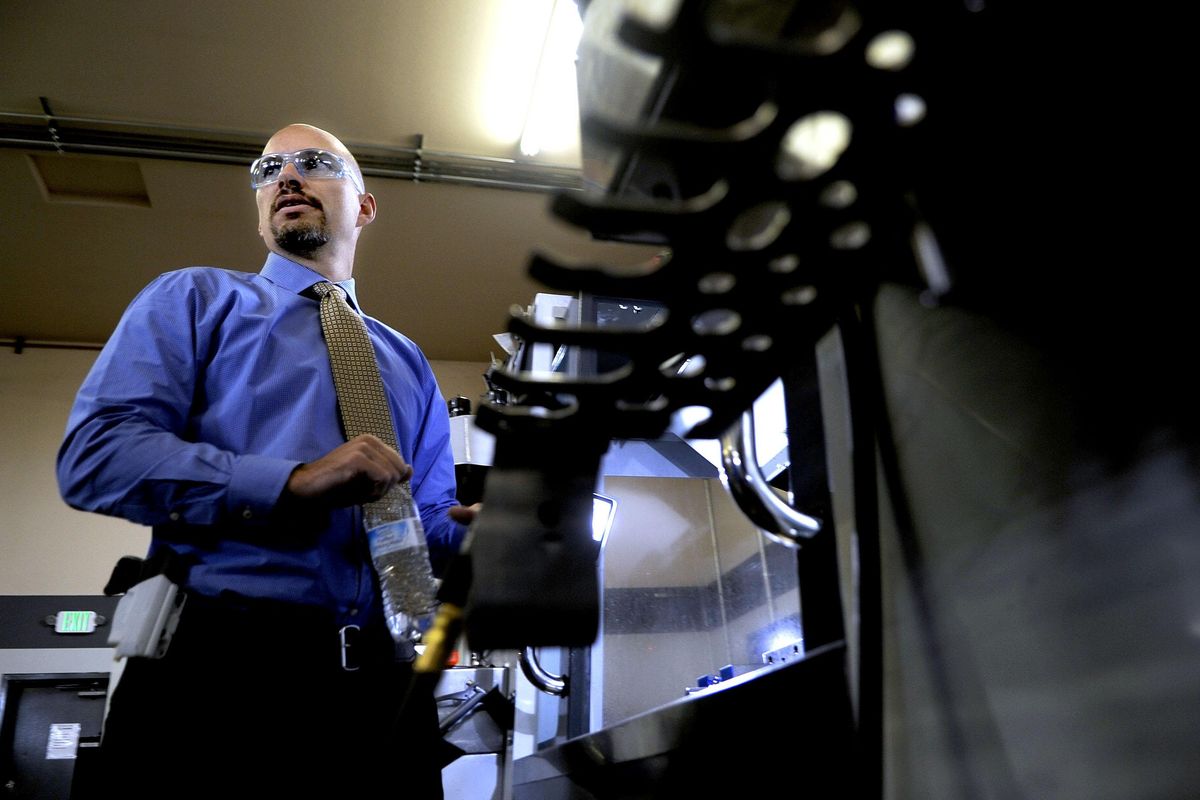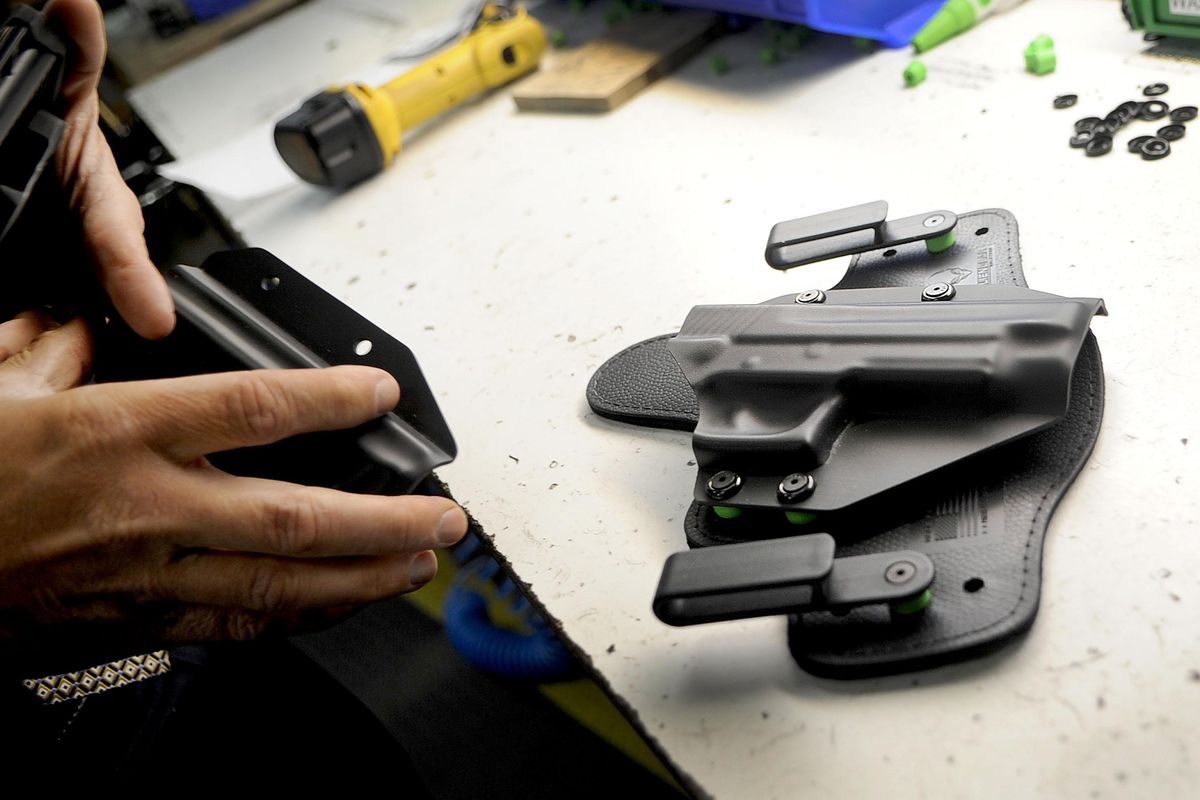Tedder aims to be industry leader in booming gun holster market
Thomas Tedder, CEO of Tedder Industries, talks about the process of making the company’s gun holsters and belts at the facility in Coeur d’Alene on Thursday, June 16, 2016. (Kathy Plonka / The Spokesman-Review)Buy a print of this photo
Six years ago, Thomas Tedder was sitting in his kitchen in Fort Smith, Arkansas, crafting a holster for his handgun. Today, he oversees a bustling North Idaho manufacturing business that each day fills hundreds of orders for concealed-carry holsters from across the U.S.
Demand for his Alien Gear holsters and Bigfoot gun belts has surged as more Americans embrace firearms in reaction to a spree of mass shootings and ongoing political debate over gun control.
“And we’re selling more this year than last year. It just keeps climbing – record gun sales every year,” said the 38-year-old CEO of Tedder Industries.
Tedder prefers not to reveal too much about his sales numbers, but business is very good.
“I can tell you that I believe we sell more to the concealed-carry market than anybody in the country,” he said. “From what we’ve seen – external polls, not conducted by us – on Reddit and ConcealedNation.org, it looks like people are using our holster for concealed carry more than anybody else.”
The company runs two shifts a day, seven days a week, with 180 employees packed tightly into three shops in Hayden and Coeur d’Alene.
Tedder keeps virtually no inventory of finished products. As orders stream in, holsters and belts are custom-made and shipped out, ideally within hours.
It’s a cyclical business, and this is the slow season. The surge comes around Christmas and tax season, when the company swells to about 280 employees.
Tedder said he recruits mostly from the area’s talent pool, including North Idaho College graduates, and has found it easy to hire employees who know and appreciate firearms.
“People like guns here. That’s one of the reasons we like being here,” he said. “They have an instant knowledge of the product.”
This fall, Tedder will consolidate the entire operation under one roof at the 20-acre Post Falls Factory Stores along Interstate 90. The company bought the long-suffering retail mall in January and has gutted the south building, which spans 90,000 square feet.
Tedder’s corporate offices, customer service and manufacturing will operate inside that building, and the company will lease the north building, which is about the same size, as a business center. So far, about 30 potential tenants are interested in moving in, Tedder said.
Aiming for the perfect fit
Tedder’s success comes from his drive to make holsters perfectly formed to fit each gun, and which are durable, adjustable and comfortable to wear.
“Conceal in comfort,” the company touts in its marketing materials.
The holsters range in price from $30 to $48, and the gun belts sell for $55 to $60.
Buyers can wear their new holster for 30 days, and if they’re not satisfied, Tedder will buy it back. The company also offers a lifetime warranty covering broken parts.
Like much of the industry today, Tedder makes hybrid holsters – a fusion of a hard synthetic shell and a softer, flexible material.
“When I started, I only had really two competitors in the hybrid holster business,” Tedder said. “Now there are hundreds of people making hybrid holsters. It’s really caught on.”
Tedder’s original brand, Old Faithful Holsters, offered a leather front, and leather is still available on the Cloak Tuck 2.0 line. But when the company came out a year ago with the latest version, the Cloak Tuck 3.0 inside-the-waistband holster, leather was replaced with thermoplastic elastomer, a rubber-like material.
Layered with the elastomer is tightly woven ballistic nylon for strength, a thin sheet of stainless steel, and waterproof neoprene, which rests against the user’s body.
The steel core – an innovation for which the company just secured a patent – helps with gun retention, keeping it more snug and secure in the holster. “The retention of this thing is amazing,” Tedder said.
He also puts a thin strip of steel inside his Bigfoot leather belts, for rigidity.
Control, quality and quick turnaround
On a recent tour of his shops, Tedder points out a group of workers assembling a custom-built machine that will sort and package spare parts included in each order, automating a time-consuming job. The extra screws and spacers allow buyers to customize the fit of their holsters.
When up and running, the sorting machine will spit out a parts packet every five seconds, and can be operated remotely.
“They’ve been working on that for a few months,” Tedder said.
The company also makes its own parts and tools using an injection molding process.
“This is the part most people have done in China,” he said. “I don’t like doing things in China.”
He wants to maintain control over the quality and inventory of the parts.
“I even bought a screw machine,” Tedder said. “We’re going to be making our own screws as soon as we have the room.”
He invests heavily in new technology, spending $150,000 on some higher-end components.
“We’re just now starting to get a lot of nice automation equipment in,” he said. “But the presses are the same presses that I designed years ago in my shed.”
The presses form each holster shell from precise molds that Tedder has made from about 250 different models of guns – a library that includes everything from the Beretta Cheetah to the Wilson Combat.
At one shop, employees make the gun belts as well as the raw materials for the holsters, which are assembled at a separate shop 3 miles away.
Tedder aims to provide buyers a tracking number for each shipment within two to four hours after the order comes in. But sometimes it can take a few days, such as in the week after the Orlando, Florida, shooting rampage.
“Anytime a terrorist starts shooting people or a politician starts talking about gun control, people get scared, they buy more guns, and then orders always spike,” he said five days after the shooting in Florida. “Right now, I think we’re about two days behind.”
From hobby to surging sales
A former software engineer, Tedder started making holsters as a hobby in Arkansas.
“I couldn’t find a nice one for the specific gun I had. It was a new gun, and nobody made a holster for that gun yet,” he explained. “So I modified a similar one, and it turned out pretty good.”
He paid $100 for some scrap leather and plastic, and formed his first holster. To mold the plastic to the shape of the gun, he used a piece of foam and a heavy book, smashed it down and stood on the book.
“I can do this,” Tedder remembers saying to himself.
He began making and selling them to friends, then on eBay, and soon was running a business with several dozen employees.
“At the time, any hybrid holster that was out there, they were like $90 or $100,” he said. “So they’ve come down in price because I really undercut them on that.”
In August 2013, he and his wife, Alicia, moved with their children to North Idaho to be near her family. Tedder incorporated that year and saw sales soar.
“I kind of came in at the right time, right as the gun industry was really taking off,” he said.
The company tapped into the surge in gun sales and concealed-carry permits over the past five or six years.
“Somebody has to buy a gun to buy a holster from us, so I think it’s all increasing in the right direction,” Tedder said. “There’s a lot of new gun owners, too. So usually when people buy one gun, they end up buying more guns.”
He has had unsolicited offers to buy the company and declined them all. Tedder expects the company’s growth will level out in the next couple of years, and he’s working to diversify with new products unrelated to firearms.
“You know, guns could get outlawed with a couple of school shootings in quick succession. You never know what can happen,” Tedder said.
His team is working on new products for the automotive industry, starting with components that integrate iPhones into car dashboards.
“We know how to manufacture, we know how to market,” Tedder said. “We know how to do all that really well, so as long as we have ideas, we’ll have products to make.”

